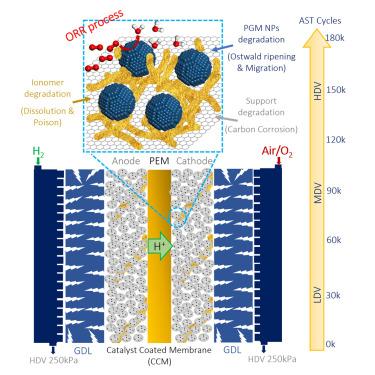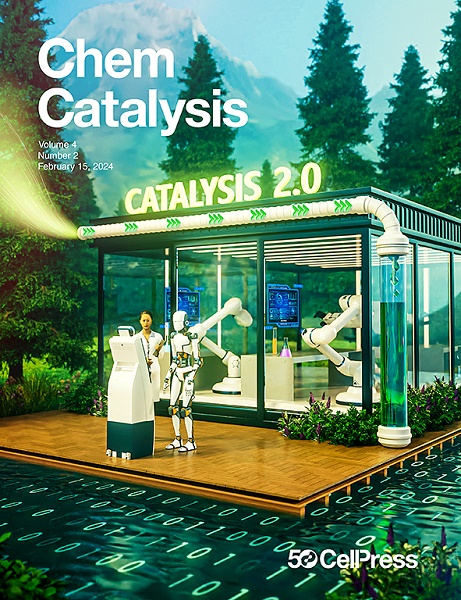重型车用聚合物电解质膜燃料电池PGM催化剂MEAs耐久性研究
IF 11.6
Q1 CHEMISTRY, PHYSICAL
引用次数: 0
摘要
聚合物电解质膜燃料电池(PEMFCs)因其清洁和高效而成为重型车辆(HDVs)的有前途的动力源。然而,膜电极组件(MEAs)在HDV条件下的降解仍然是一个巨大的挑战。这项工作使用了美国能源部标准的加速压力测试,进行了18万次循环(相当于100万英里的HDV运行),研究了HDV条件下MEA的耐久性。采用自制30% Pt/C (H-Pt/C)和商用46% Pt/C (C-Pt/C)催化剂考察了催化剂Pt含量对MEA耐久性的影响。两个mea在循环过程中都经历了H2/air和H2/O2性能损失。扫描透射电子显微镜、x射线衍射、电感耦合等离子体质谱和汞侵入孔隙度分析显示,Pt纳米颗粒(NPs)、支撑结构和催化剂层严重降解。NPs的降解分为两个阶段:奥斯特瓦尔德成熟主导了最初的6万个循环,其次是奥斯特瓦尔德成熟和颗粒迁移的结合。离子色谱、高频电阻和氧扩散电阻的测量分别显示了膜和离聚体的降解。本文章由计算机程序翻译,如有差异,请以英文原文为准。

Durability of PGM catalyst MEAs of polymer electrolyte membrane fuel cells for heavy-duty vehicles
Polymer electrolyte membrane fuel cells (PEMFCs) are promising power sources for heavy-duty vehicles (HDVs) owing to cleanliness and efficiency. However, the degradation of membrane electrode assemblies (MEAs) under HDV conditions remains a huge challenge. This work investigated MEA durability under HDV conditions using a US Department of Energy standard accelerated stress test for 180,000 cycles (equivalent to 1 million miles of HDV operation). Effects of catalyst Pt content on MEA durability were examined using homemade 30% Pt/C (H-Pt/C) and commercial 46% Pt/C (C-Pt/C) catalysts. Both MEAs experienced H2/air and H2/O2 performance loss over cycles. Analysis with scanning transmission electron microscopy, X-ray diffraction, inductively coupled plasma mass spectrometry, and mercury intrusion porosimetry revealed severe degradation of Pt nanoparticles (NPs), support structures, and the catalyst layer. Two degradation stages for NPs were proposed: Ostwald ripening dominated the initial 60,000 cycles, followed by combined Ostwald ripening and particle migration. Measurements with ion chromatography, high-frequency resistance, and oxygen-diffusion resistance revealed degradation of membrane and ionomer, respectively.
求助全文
通过发布文献求助,成功后即可免费获取论文全文。
去求助
来源期刊
CiteScore
10.50
自引率
6.40%
发文量
0
期刊介绍:
Chem Catalysis is a monthly journal that publishes innovative research on fundamental and applied catalysis, providing a platform for researchers across chemistry, chemical engineering, and related fields. It serves as a premier resource for scientists and engineers in academia and industry, covering heterogeneous, homogeneous, and biocatalysis. Emphasizing transformative methods and technologies, the journal aims to advance understanding, introduce novel catalysts, and connect fundamental insights to real-world applications for societal benefit.

 求助内容:
求助内容: 应助结果提醒方式:
应助结果提醒方式:


